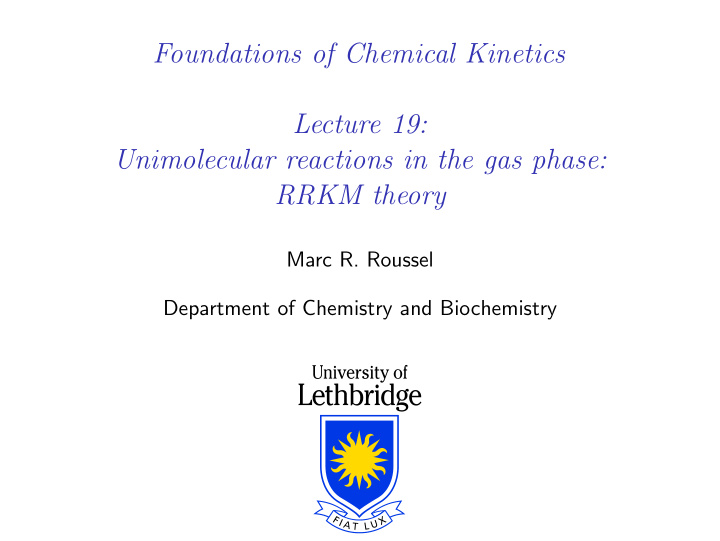



Foundations of Chemical Kinetics Lecture 19: Unimolecular reactions in the gas phase: RRKM theory Marc R. Roussel Department of Chemistry and Biochemistry
Canonical and microcanonical ensembles Canonical (constant T ) ensemble Average over a � Boltzmann distribution Microcanonical (constant E ) ensemble
The M in RRKM ◮ RRKM theory is an extension of RRK theory developed by R. A. Marcus (Canadian, Nobel Prize winner 1992). ◮ RRKM theory is intended to improve on RRK theory by eliminating arbitrary assumptions. ◮ RRKM is a microcanonical transition state theory: Microcanonical: Rate constant calculated at energy E Canonical rate constant (i.e. the normal temperature-dependent k ) recovered by averaging over a Boltzmann distribution Transition-state theory: RRKM connects TST with statistical theories
Assumptions of RRKM theory ◮ The assumed mechanism is the same as in RRK theory: ◮ Collisional activation, followed by ◮ Intramolecular vibrational relaxation leading to the transition state ◮ As in RRK theory and TST, it is assumed that energized molecules pass through the transition state just once. Note: There is a variational version of RRKM theory in which we try to ensure that this is so.
Assumptions of RRKM theory ◮ Internal degrees of freedom of the energized molecules are designated as either Adiabatic: quantum state doesn’t change during reaction, or Active: energy exchanged between active modes during reaction ◮ Adiabatic modes are often associated with conserved quantities, e.g. Rotation around system centre of mass � conservation of angular momentum ◮ Most internal (normal) modes would be active.
Assumptions of RRKM theory ◮ Proper quantum mechanical treatment of vibration and rotation ◮ No assumptions about frequencies of normal modes ◮ Harmonic approximation normally used, but not necessary ◮ Exact counting of states possible (i.e. no approximation of partition functions)
RRKM theory vs experiment ◮ RRKM theory has passed two different types of tests: 1. Calculation of the thermal k ( T ) and comparison to experiment 1.1 Using experimental frequencies, geometries, etc. 1.2 Using parameters obtained from ab initio calculations 1.3 Fitting some parameters of model using experimental data 2. Calculation of the microcanonical rate constant k ( E ) and comparison to experiment ◮ Experiments involve preparation of reactants in known states and subsequent measurement of reaction rate
Non-RRKM behavior ◮ The central assumption of RRKM theory is a division of modes into adiabatic and active, with energy redistribution between active modes being fast enough that a random distribution results on a time scale much faster than that for reaction. ◮ In some reactions, there are modes that are not adiabatic, but from which energy flows slowly. ◮ Possible causes: ◮ Strictly harmonic vibrational modes would truly be normal. Accordingly, modes that are only weakly anharmonic tend not to equilibrate with the others quickly. ◮ Rotational modes can couple weakly to the vibrational modes.
Non-RRKM behavior (continued) ◮ Imagine a non-reactive mode that contains excess energy which is only slowly released to the other modes. ◮ As a result, the probability that the reactive mode acquires sufficient energy would increase with time, leading to a time-dependent rate constant.
Review of unimolecular reaction rate theories Lindemann mechanism: ◮ Starting point for all theories of gas-phase unimolecular reactions ◮ Assumes that molecules are energized by collision Hinshelwood theory: ◮ Brings in idea of internal modes as storage bins for energy ◮ Because there are many modes, there are many ways to store a given amount of energy. ◮ This enhances the probability of reaching the activation energy for a reaction.
Review of unimolecular reaction rate theories RRK theory: ◮ Brings “transition-state thinking” into statistical theories ◮ Assumes that energy is rapidly exchanged between internal modes ◮ Requires sufficient energy to accumulate in reactive mode in order for reaction to occur RRKM theory: ◮ A microcanonical transition-state theory ◮ Allows for a proper quantum-mechanical treatment of all internal modes ◮ Divides modes into active (rapidly equilibrating) and adiabatic
Recommend
More recommend